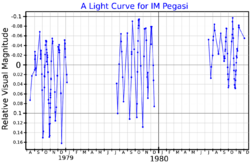Astronomy:IM Pegasi
| Observation data Equinox J2000.0]] (ICRS) | |
|---|---|
| Constellation | Pegasus |
| Right ascension | 22h 53m 02.26608s[1] |
| Declination | +16° 50′ 28.2969″[1] |
| Apparent magnitude (V) | 5.55[2] (5.60 – 5.85[3]) |
| Characteristics | |
| Spectral type | K2 III + dG[4] |
| Variable type | RS CVn[3] |
| Astrometry | |
| Radial velocity (Rv) | −14.43[5] km/s |
| Proper motion (μ) | RA: −20.73[1] mas/yr Dec.: −27.75[1] mas/yr |
| Parallax (π) | 11.17 ± 0.33[1] mas |
| Distance | 292 ± 9 ly (90 ± 3 pc) |
| Orbit[2] | |
| Period (P) | 24.64877±0.00003 d |
| Eccentricity (e) | 0.00 |
| Inclination (i) | 65° ≤ i ≤ 80°° |
| Semi-amplitude (K1) (primary) | 34.29±0.04 km/s |
| Semi-amplitude (K2) (secondary) | 62.31±0.06 km/s |
| Details[4] | |
| primary | |
| Mass | 1.8 ± 0.2 M☉ |
| Radius | 13.3 ± 0.6 R☉ |
| Luminosity | 54 ± 9 L☉ |
| Temperature | 4,550 ± 50 K |
| Rotation | 24.4936 days |
| secondary | |
| Mass | 1.0 ± 0.07 M☉ |
| Radius | 1.00 R☉ |
| Luminosity | 0.9 ± 0.3 L☉ |
| Temperature | 5,650 ± 200 K |
| Other designations | |
IM Peg, HD 216489, HIP 112997, HR 8703, SAO 108231 | |
| Database references | |
| SIMBAD | data |
IM Pegasi is a variable binary star system approximately 329 light-years away in the constellation of Pegasus. With an apparent magnitude of 5.7, it is visible to the naked eye. Increased public awareness of it is due to its use as the guide star for the Gravity Probe B general relativity experiment. It was chosen for this purpose because its microwave radio emissions are observable with a large radio telescope network on the ground in such a manner that its precise position can be related by interferometry to distant quasars.[6]
The two components of the binary system includes a K-type giant star and a G-type main sequence star. The primary star is estimated to be 1.8 times as massive and 13 times the diameter of the Sun. The secondary star is estimated to be similar to the Sun in size and mass. They orbit their common barycenter in a period precisely estimated to be 24.64877 days.

The variability of IM Pegasi is due to the active chromosphere of the giant primary star, which causes brightness changes of a few tenths of a magnitude as it rotates.
References
- ↑ 1.0 1.1 1.2 1.3 1.4 Van Leeuwen, F. (2007). "Validation of the new Hipparcos reduction". Astronomy and Astrophysics 474 (2): 653–664. doi:10.1051/0004-6361:20078357. Bibcode: 2007A&A...474..653V.
- ↑ 2.0 2.1 Berdyugina, S. V.; Ilyin, I.; Tuominen, I. (1999). "The long-period RS Canum Venaticorum binary IM Pegasi. I. Orbital and stellar parameters". Astronomy and Astrophysics 347: 932. Bibcode: 1999A&A...347..932B.
- ↑ 3.0 3.1 Samus, N. N. et al. (2009). "VizieR Online Data Catalog: General Catalogue of Variable Stars (Samus+ 2007-2013)". VizieR On-line Data Catalog: B/GCVS. Originally Published in: 2009yCat....102025S 1. Bibcode: 2009yCat....102025S.
- ↑ 4.0 4.1 Zellem, Robert; Guinan, Edward F.; Messina, Sergio; Lanza, Antonino F.; Wasatonic, Richard; McCook, George P. (2010). "Multiband Photometry of the Chromospherically Active & Spotted Binary System IM Peg-the Guide Star for the Gravity Probe B Mission". The Publications of the Astronomical Society of the Pacific 122 (892): 670. doi:10.1086/653711. Bibcode: 2010PASP..122..670Z.
- ↑ Karataș, Yüksel; Bilir, Selçuk; Eker, Zeki; Demircan, Osman; Liebert, James; Hawley, Suzanne L.; Fraser, Oliver J.; Covey, Kevin R. et al. (2004). "Kinematics of chromospherically active binaries and evidence of an orbital period decrease in binary evolution". Monthly Notices of the Royal Astronomical Society 349 (3): 1069–1092. doi:10.1111/j.1365-2966.2004.07588.x. Bibcode: 2004MNRAS.349.1069K.
- ↑ Shapiro, I. I.; Bartel, N.; Bietenholz, M. F.; Lebach, D. E.; Lestrade, J.-F.; Ransom, R. R.; Ratner, M. I. (2012). "VLBI for Gravity Probe B. I. Overview". The Astrophysical Journal Supplement 201 (1): 1. doi:10.1088/0067-0049/201/1/1. Bibcode: 2012ApJS..201....1S.
- ↑ Eaton, J. A.; Hall, D. S.; Henry, G. W.; Lovell, L. P.; Stephan, C. A.; Chambliss, C. R.; Detterline, P. K.; Landis, H. J. et al. (January 1983). "Three Years of Photometry of IM-Pegasi = HR8703". Astrophysics and Space Science 89 (1): 53–60. doi:10.1007/BF01008384. Bibcode: 1983Ap&SS..89...53E. https://ui.adsabs.harvard.edu/abs/1983Ap&SS..89...53E. Retrieved 12 February 2022.
External links
- A map of where IM Pegasi appears on the sky
- "Gravity Probe B: Frequently Asked Questions". Stanford University. http://einstein.stanford.edu/content/faqs/faqs.html.
- "IM Pegasi". York University. http://www.yorku.ca/bartel/guidestar/.
- VLBI Imaging and Astrometric Results for IM Pegasi
 |


